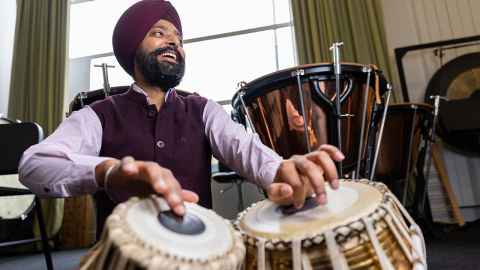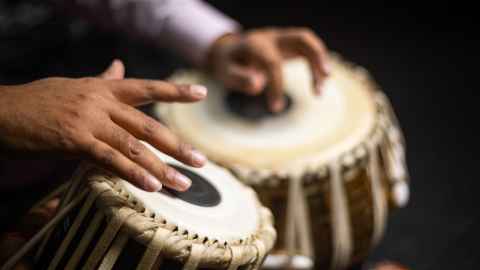Manjit Singh brings Indian rhythms to Music School
31 August 2022
Manjit Singh’s quest to bring Indian ragas music into mainstream music education has involved going from teacher to student to teacher.

Manjit Singh’s first impression of New Zealand was Waikato in 2008.
He thought it looked and felt just like his homeland, Punjab in India. He had been touring England playing tabla – a pair of hand drums fundamental to classical Indian music - when he was offered a trial job in Hamilton. The local Sikh association wanted him to teach classical Indian music to children.
Manjit started with teaching a class of around 50 children in Cambridge, mainly at the behest of their parents. When he visited Auckland on weekends, the local Sikh Gurudwara (temple) also enlisted him to teach. What started as an informal class outside the Gurudwara on a Sunday, soon expanded to a class of 60 students who were not just Punjabi but also included Gujarati, Marathi and Fiji-Indian children.
Manjit soon realised that, for his Kiwi-Indian students, his class was more than a music class.
“I wasn’t just teaching them how to create music, like my classes in India. Through playing the tabla and learning Hindustani vocals, my students were also learning about their culture. They were exploring what it means to be an Indian.”
When Manjit became a father, he had a choice. Move back to India to be with his family and continue his career as a performer or ask his wife Daljeet – also a classically trained Indian musician – to join him in Aotearoa and start the Rhythm School of Indian Music (rhythmschool.co.nz).
The school specialises in teaching Hindustani vocals, Gurmat Sangeet (a Sikh music tradition), tabla, dilruba, sitar and violin at the highest professional level of the North Indian classical tradition.
“I realised that just starting the music school wasn’t enough. These children we were teaching were so musically talented. But at school they were embarrassed to call themselves musicians. They felt like the music they played only belonged in temples. There was a real need for someone to go into the mainstream and connect the dots.
“I realised then that I didn’t know much about mainstream music education myself. Everything I knew about classical Indian music I knew through my guru under whose tutelage I learned. I became a teacher when he declared I was ready to be one. In New Zealand though, that wasn’t enough.”
Through playing the tabla and learning Hindustani vocals, my students were also learning about their culture. They were exploring what it means to be an Indian.
Manjit realised he had to become a student again. However, when he first applied to study for a masters at the University’s School of Music, his application was declined.
“I was told that, since I didn’t have any understanding of Western classical music, I had to go back to undergraduate level. As someone who had studied tabla for 15 years, performed internationally and been teaching, initially it felt like a huge step backwards.”
As Manjit studied, he learned how Indian classical music was different from Western classical music and also how it was similar.
“Learning both sides really shaped me. I learned how to become a hybrid music teacher.”
While Manjit continued to learn and perform both in New Zealand and internationally, it was an opportunity to teach tabla at Botany Secondary College that prompted him to complete his postgraduate studies in music.
“At my college course, I taught many students. What surprised me was that they wanted to learn even though the course had no formal NCEA credits attached.
“One of the Chinese students I taught at Botany followed me to my music school. He started learning tabla because he liked Indian food and loved music. Today, he’s a fabulous tabla player and famous within the Indian community in Aotearoa. Gurudwaras across the country invite him to come and play for them.”
It became Manjit’s dream to create an Indian music curriculum for NCEA and that became the basis of his masters research, developing a Model of Indian Music Studies for New Zealand Classrooms.
Manjit graduated with his masters in September and is now a professional teaching fellow in the School of Music. His next mission is to work with NZQA to implement his research so that Indian Music can be introduced as an NCEA paper in secondary schools. While that may take time, Manjit continues to role model how tabla can be grooved across genres and musical styles. Some of the musicians he has worked with include jazz legends Nathan Haines and Jonathan Crayford, as well as hip-hop star Tom Scott with whom he performed live at the Vodafone Music Awards.

One of the Chinese students ... started learning tabla because he liked Indian food and loved music. Today, he’s a fabulous tabla player and famous within the Indian community in Aotearoa.
An important chapter in Manjit’s journey to bring tabla to mainstream music education is the School of Music’s new paper, Ragas of India.
“This paper is a culmination of my work in music education. Learning tabla’s ragas and talas – musical beats – helps students with their composition and improvisation skills. It’s a skill they can apply to all of their music.
“Ragas also opens up doors for other ethnic music. We can all benefit from a more diverse music classroom. After all, food, fashion and music are the platforms through which we change the culture around us.”
Manjit Singh will perform at the upcoming Auckland Diwali Festival which runs 8-9 October at Aotea Square and Queen Street.
This story first appeared in the September 2022 edition of UniNews.
Email: uninews@auckland.ac.nz